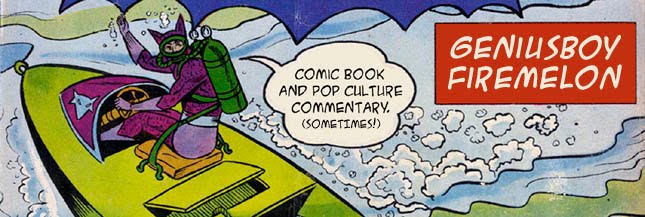Hello, loyal readers! Richard Oldstate here. My good friend and ice-fishing companion Timothy has asked me to fill in for him during his trip. While I lack Mr. Callahan's encyclopedic knowledge of the comic book medium, I make up for it by being several inches taller. I also have much cooler facial hair. And so I begin:
The 1970's was a turbulent and exciting period in the comics industry. It was a boom period full of experimentation, both on and off the page. Many trendsetting authors and artists began their career during this amazing period, while others showed a brief flash of brilliance only to quickly burn out, like a light bulb with substandard filament.
Earl Somerlath (b. 1947) began his comic career, as many before and after, as a fan. He would read comics by the dozen and overwhelm editors with his frequent letters. No continuity error was too small, no typo too insignificant for one of Mr. Somerlath's scathing letters to the "editor" (quotations his). One particular nineteen page letter, which focused solely on the scientific inability of a dog flying a spaceship, greatly impressed a young publisher by the name of Hal Turtin. Mr. Turtin decided that Somerlath's strongly worded missives and obsession with historical minutiae would make him the perfect man to craft a series of more realistic super hero comics.
The first comic penned by Somerlath, The Amazing and Verified Exploits of the Super-Mustachioed-Man, was a gigantic success, selling over three hundred copies in the first year alone, a very impressive number for that era. The book, featuring the exploits of a gay 90's barkeep with a well kept handlebar moustache and the "most striking arm-garters south of 4th street," enjoyed an impressive (again, for the era) twenty-three issue run. Greatly enjoying the books many profits and yearning for more, Turtin convinced Somerlath to give one of the books many minor characters his own title.
The resulting title, The Ombudsman, attracted less success. Although fans and critics alike marveled at the realistic depiction of a 19th century Norwegian fishing village, they quickly grew tired of stories about maritime fact-checking and the ethics of journalism at sea. The title lasted only four issues.
The news wasn't all bad for Somerlath. The slight success of The Amazing and Verified Exploits of the Super-Mustachioed-Man allowed him to concentrate on more personal and less commerical works, none of which he ever completed. During this period, he also dipped his toes in the sea of Hollywood, penning unsolicited and unread scripts for Jaws 2, The French Connection 2, Bullit 2, Bullit 3, Murder on the Orient Express 2, and Kramer vs. Kramer 2.
Desperate for another hit to saving his dying company, Turtin again turned to Somerlath. Over a long weekend in Wilkes-Barre, the two hammered out the details for the the title that would surely set the world of comics on its ear. Thrilling Tales of Cunning!, as conceived by Turtin and Somerlath, would feature three stories an issue, each with a tale of everyday men and women overcoming adversity and defeating the bad guys with nothing but pluck, common sense and good, old-fashioned, American ingenuity.
Not much is known about the cross country trip Somerlath took after that weekend in Wilkes-Barre. He left Pennsylvania on Friday with his wife and two children. He arrived at his home in Sacramento the following Thursday. His wife and children were nowhere to be seen. He was a broken man who cried at the drop of a hat or the honk of a passing car's horn. He spent the next fourteen days locked in his study, writing.
When he emerged, he did not hold the Thrilling Tales of Cunning! script in his hands. He held something different. Something new. Something the world of sequential art had never seen.
Factual Tales of Cowardice was not the hit Turtin was expecting. Though exhaustively well-researched, this three issue anthology series disappointed fans and critics alike. The fact that every story ends with the de facto "hero" running away, being beaten senseless, or breaking down in tears as his wife and two children are set afire before his eyes by a gang of renegade bikers does become a bit off putting.
After the complete failure of Factual Tales of Cowardice, Turtin fired Somerlath and the two never spoke again. Somerlath self-published one title: Kat Fancy. This detective title, about an eighty-three year old, seven-hundred and four pound women who solved crimes from her sick bed with the help of her eleven cats, suffered from many of Somerlath's bewildering creative choices. Firstly, Somerlath, never an artist, chose to draw the book himself, which explains why he chose to set it entirely in the tiny sick room of a elderly, morbidly obese invalid. Every panel contains the same drawing of a women in bed, surrounded by cats. Secondly, Somerlath greatly undercuts any possible drama inherent in a detective story by writing in his introduction, "cats are the slowest of tamed beasts and are incapable of even the most rudimentary English. Their attempts at detection would be laughable at best. Please enjoy the following made-up, implausible story."
Somerlath never wrote another word after Kat Fancy. Today he resides in Oxnard, California and can be found sitting quietly at his great-niece's swim meets.

No comments:
Post a Comment